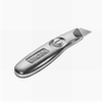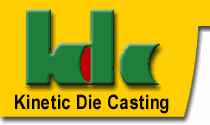Zinc Die Casting Parts Company
Kinetic Die Casting Company is also a Zinc Die Casting Parts Company. Kinetic Die Casting Company makes diecast parts in zinc,
(zinc die castings), as well as our aluminum die casting parts. Brass can also be die cast but not by Kinetic Die Casting company.
Zinc die casting alloy is also known as zamak and includes the family of zinc-aluminum (ZA) die casting alloys.
(ZN) Zinc die casting alloys offer a broad range of excellent physical and mechanical properties, castability, and finishing characteristics.
Thinner sections can be die cast in zinc alloy than in any of the commonly used die casting alloys.
Zinc alloy generally allows for greater variation in section design and for the maintenance
of closer dimensional tolerances. The impact strength of zinc components is higher than other die casting alloys, with the exception of brass.
Due to the lower pressures and temperatures under which zinc alloy is die cast, die life is significantly lengthened and die maintenance minimized.
There are several differences between aluminum and zinc parts. Zinc Diecast Parts weigh more than aluminum.
Zinc melts at a lower temperature than aluminum. Zinc parts require less draft angle. Zinc is more malleable than aluminum.

|
Kinetic Die Casting Company
818-982-9200
sales@kineticdc.com
|

|
There are two processes used by a Zinc Die Casting Parts Company to make zinc parts,
the hot-chamber zinc die casting method and the cold-chamber zinc die casting method:
- The hot-chamber zinc die casting method, an internal plunger system injects the zinc from a pool of molten zinc metal to fill the steel die while maintaining pressure until the zinc metal hardens in the diecasting die.
- The cold-chamber zinc die casting method, on the other hand, uses separate chambers to melt and then hold the melted zinc metal before pouring
the zinc alloy into a die casting shot cylinder and injecting the zinc metal into the die casting dies.
A zinc die casting company
uses various zinc metal alloys in the production of parts using the die casting process.
Tin and lead were the first metal alloys that were used by die casting companies for die casting of metal printer’s types. Throughout the years,
a number of other metal alloys ensued as medium by die casting companies for metal parts. Among the most popular metal alloys is the zinc die casting alloy.
Kinetic Die Casting Company
uses all of these
zinc die casting alloys
to make zinc diecasting parts.
There are four traditional zinc diecasting alloys in the conventional zinc group, which are often referred to commercially as the “Zamak” alloys
(an acronym for zinc, aluminum, magnesium and copper). Zamak is also referred to as Zamac. Zinc die casting alloys include the ZA Alloys
(Zinc-Aluminum die casting alloys). Below is a chart of these alloys with their ASTM designations.
|
Zinc Die casting Alloys |
Zamak Die casting Alloys |
ASTM Designations |
|
Zinc Alloy #2 |
Zamak 2 |
AC43A |
|
Zinc Alloy #3 |
Zamak 3 |
AG40A |
|
Zinc Alloy #5 |
Zamak 5 |
AC41A |
|
Zinc Alloy #7 |
Zamak 7 |
AG40B |
|
Zinc-Aluminum ZA8 |
- |
- |
|
Zinc-Aluminum ZA12 |
- |
- |
|
Zinc-Aluminum ZA27 |
- |
- |
The physical properties of different die casting alloys make the difference as to why choose a specific alloy.
In some cases a die casting tool is capable of making parts in more than one alloy. Some alloys are lighter in weight or are stronger.
The following chart breaks down the different properties; this is not a complete list of zinc die casting alloy phisical properties.
A more complete listing of
die casting alloys can be found here.
| Physical Properties of Zinc Alloys |
#2 Zinc Diecasting Alloy |
#3 Zinc Diecasting Alloy |
#5 Zinc Diecasting Alloy |
#7 Zinc Diecasting Alloy |
ZA-8
Zinc Aluminum Alloy |
ZA-12 Zinc Aluminum Alloy |
ZA-27 Zinc Aluminum Alloy |
| Tensile
strength, psi x 1000 |
52 |
41 |
48 |
41 |
54 |
59 |
62 |
| Yield Strength,
psi x 1000 |
41 |
32 |
39 |
32 |
41—43 |
45—48 |
52—55 |
|
Elongation pct in 2 in. |
7 |
10 |
7 |
13 |
6—10 |
4—7 |
2—3.5 |
| Hardness |
100 |
82 |
91 |
80 |
100—106 |
95—105 |
116—122 |
| Impact Strength |
35 |
43 |
38 |
43 |
24—35 |
15—27 |
7—12 |
| Density lb/in3 |
0.24 |
0.24 |
0.24 |
0.24 |
0.227 |
0.218 |
0.181 |

Die Casting Alloy Zinc No. 3 is the most widely used zinc die casting alloy in North America, offering the best combination of mechanical properties, castability,
and economics. It can produce castings with intricate detail and excellent surface finish at high production rates. The other alloys
in the Zamak group are slightly more expensive and are used only where their specific properties are required
Die Casting Zinc Alloys 2 and 5 have a higher copper content,
which further strengthens wear resistance,
but at the expense of dimensional and property stability. No. 5 offers higher creep resistance and somewhat lower ductility
and is often preferred whenever these qualities are required.
Die Casting Alloy Zinc No. 7 is a special high-purity alloy which has better fluidity and
allows thinner walls to be cast.
The ZA die casting alloys contain substantially more aluminum than the Zamak group, with the numerical designation representing the ZA alloy’s approximate
percent Al content.
The higher aluminum and copper content of the ZA alloys give them several distinct advantages over the traditional zinc alloys, Including higher
strength, superior wear resistance, superior creep resistance and lower densities.
Die Casting Processes
Brass Parts Die Casting.
Tooling Die Casting.
Die Casting Draft Angle.
Alloys for Die Casting.
Aluminum Die Casting Company.
Zinc Parts Die Casting.
Magnesium Die Casting Company.
Porosity in Die Castings.
Sand Castings.
Technical Die Casting Terms.
Die Castings Compared to Steel.
Die Castings Compared to Plastic.
Capabilities of Die Casting.
Why use Diecasting.
What is Die Casting.
American Die Casting Company.
Manufacturing Die Castings.
Custom Metal Parts.
Diecast Quality Production.
Die Casting Aluminum.
Diecasting Company.
Kinetic Die Casting Company.
Kinetic Die Casting Company, 6918 Beck Avenue, Los Angeles, California USA 91605
| 




